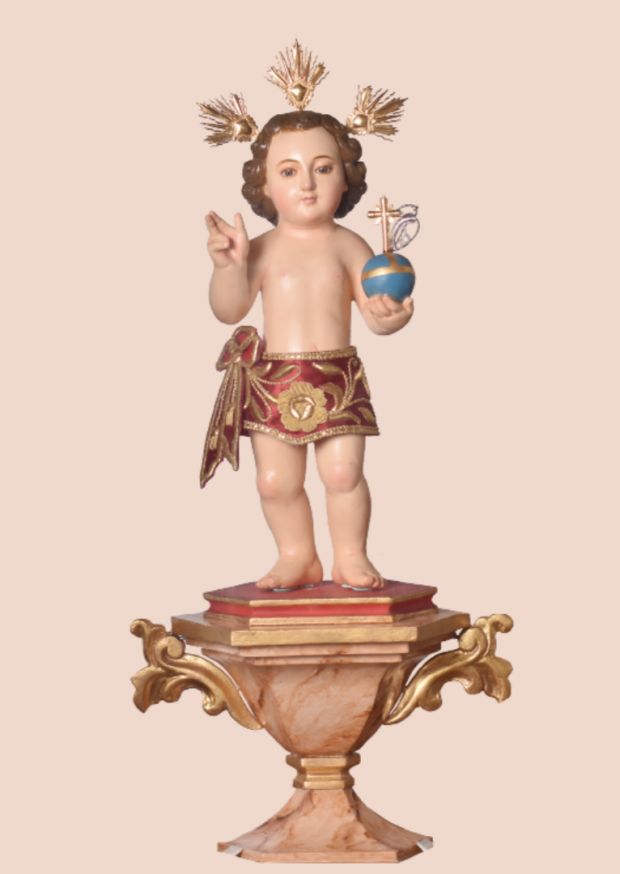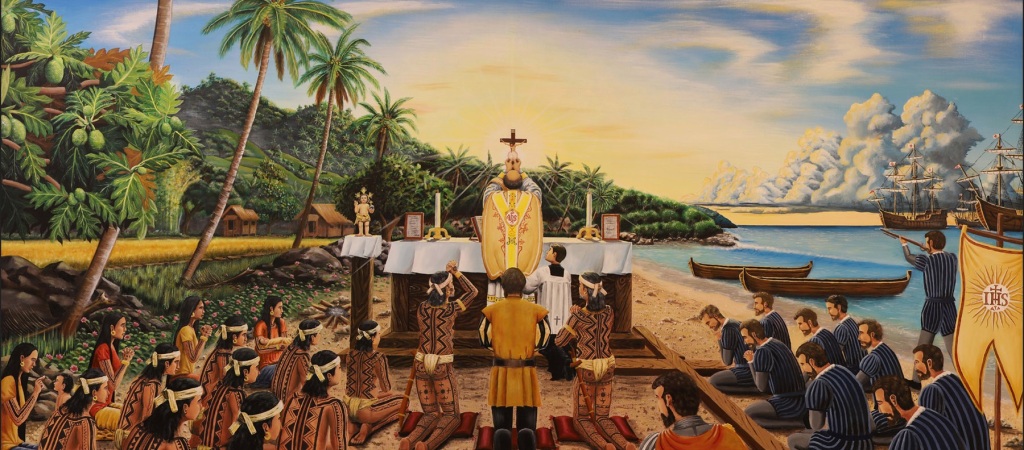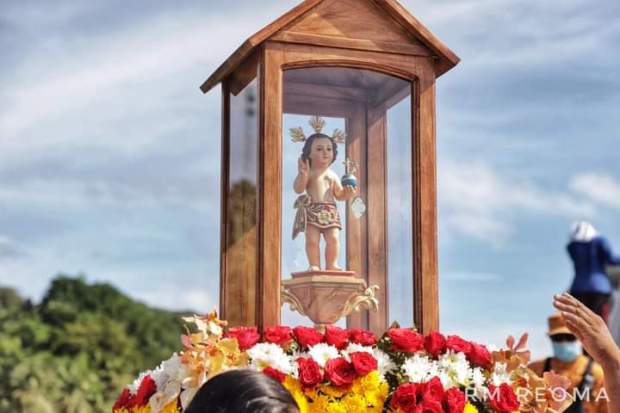
The celebration of the 500 Years of Introduction of the Catholic faith in the Philippines is indeed an important event in our Church and the nation. The pandemic may have forced a subdued celebration of this milestone, yet the Philippine Catholic Church was able to adapt ways to make the celebrations memorable.
Amid this important historical event, an image of the Child Jesus, a perpetual symbol of the Catholic faith in the archipelago, stands as a tangible memorial etched in our collective piety and history. This image is the Santo Niño de Limasawa which its devotion is gradually growing in the Diocese of Maasin as of this writing.
The image

The lovely and smiling image of Santo Niño de Limasawa is a wooden image of the Child Jesus standing upright on an ornate base, wears an embroidered tapis, his right hand is in a gesture of blessing while his left is holding a globus cruciger – a symbol of power. His curly hair is carved in a Flemish style which can be seen in the image of Santo Niño de Cebu and other European images of the Child Jesus.
On how the Santo Niño de Limasawa was presented in this manner, Rev. Fr. Mark Vincent Salang, Chancellor of the Diocese of Maasin notes that they decided to present him “almost naked [with His tapis], because we believe that is how most likely the Santo Niño was given to Cebu […] Removing all the regalia, we come to realize that our beginnings were simple [that it occurred on a small island].” He also make emphasis on Christ’s humanity and his humble birth.
A lookback

Let us have a look back on how the Catholic faith was introduced in our country to understand the context of the devotion of Sto. Niño de Limasawa.
After long months of the voyage from Spain, Ferdinand Magellan and his crew landed in the Philippines, on March 17, 1521, the Spanish expedition led by Ferdinand Magellan landed on the island of Homonhon, which they first sighted the previous day. Antonio Pigafetta, the chronicler of Magellan’s expedition, recorded the following: “We found two fountains of very clear water; we called it the `Waters of Good Signs,’ having found the first sign of gold in the said island. There also can be found much white coral and tall trees that bear fruits smaller than an almond and look like pines. There were also many palm trees, some of the good kind, some of the bad. Thereabouts are many neighboring islands. Hence, we called them the St. Lazarus Archipelago because we stayed there on the day and feast of St. Lazarus.”
The following day, Magellan and his crew landed on an uninhabited island known as Homonhon. The crew met the friendly natives from neighboring islands and brought food for them and a feast happened.

On March 31, 1521, the First Documented Mass in the Philippines was offered by Rev. Fr. Pedro de Valderrama for the celebration of Easter Sunday. A big Cross was also planted in the area.
It was hotly debated whether if the First Mass took place either in Limasawa Island, Southern Leyte or in Butuan, Agusan del Norte. The recent ruling of the National Historical Commission of the Philippines in 2020, that was upheld by the Church Historians’ Association of the Philippines in 2021, recognized Limasawa Island as the site of the First Mass in the country.
A few days later, the Magellan crew set sailed to Cebu when they met Raja Humabon and the first baptism was held. An image of the Child Jesus, the Santo Niño de Cebu, was given to his wife Reina Juana as a baptismal gift. The expedition went to an abrupt end with the Battle of Mactan where Magellan was killed and left Cebu to the Moluccas to get the spices needed for trade in Europe. The Spaniard later returned in 1565 headed by Miguel Lopez de Legazpi which formally begin the conquista and Christianization of the Philippines.
A perpetual memorial

The Diocese of Maasin conceived the plan to have an image of the Child Jesus for the celebration of the 500 Years of Christianity in the Philippines a few years before the celebrations commenced. The plan however was shelved for a time until the projects for the then upcoming 500th year celebrations were reviewed. Upon realizing the significance of the Santo Niño, the Holy Eucharist and the Holy Cross in the beginnings of our history, the plan to have the image made commenced. The image was carved by Mr. Bong Primitivo Lauderis and completed by the Atelier Rafael Lopez.

The image first brought to San Agustin Church in Intramuros, Manila, together with the restored images of Santo Niño de las Mercedes and recovered Santo Niño de Malitbog on November 26, 2020. The three Visayan Santo Niños visited the Parish of Santo Niño de Pandacan in Pandacan, Manila days after the parish and the original image was caught on fire that caused their destruction. The next day, November 27, 2020, Feast of Our Lady of the Miraculous Medal, the three Niños arrived at the chapel of Nuestra Señora de las Mercedes in Catbalogan, Samar for the homecoming of Santo Niño de las Mercedes. Moments later, that same day, the images of Malitbog and Limasawa left for the Archdiocesan Shrine of Santo Niño de Tacloban before coming home to Southern Leyte.
The images arrived in Southern Leyte the following day where the image of Santo Niño de Malitbog made his homecoming since the theft of the image in the 1990s while the Santo Niño de Limasawa on the other hand was kept at the Bishop’s residence in Maasin City, Southern Leyte.
The devotion to Santo Niño de Limasawa was formally launched on January 17, 2022, the Philippine Feast of the Santo Niño, at the Cathderal and Diocesan Shrine of Our Lady of the Assumption. The image was enthroned at the Cathedral for a time until it was enthroned at the Parish of the Holy Cross and of the First Mass in Limasawa, Southern Leyte on March 30, 2021 as part of the celebration of the 500 Year Jubilee Celebrations in the country.
At present, the image is enshrined in Limasawa for veneration of the faithful while a two replicas are in place, one enthroned at the baptistry of Maasin Cathedral – Shrine while the other would visit each parish, barangay and town within the diocese to help foster the devotion further to the faithful.
The devotion

Although the image and the devotion to Santo Niño de Limasawa is recent, the faithful of the Diocese of Maasin grew to love the Holy Child of Limasawa as the devotion grew gradually in the diocese and the province of Southern Leyte. The Feast of the Santo Niño de Limasawa is celebrated every Third Sunday of January. For the solemn novena, the image is brought to Maasin Cathedral for veneration of the faithful and the fiesta and solemn fluvial and terrestrial procession is held at the Limasawa Island.
The history and the Catholic faith in the Philippines is forever intertwined with the devotion to the Santo Niño for centuries. The Santo Niño de Limasawa helps us to remind our humble beginnings and how a small child would shape our national identity up to the present.
As we end this blogpost, here is the official prayer to the Santo Niño de Limasawa released by the Diocese of Maasin:
Señor Santo Niño de Limasawa, we approach You as the Lord of the universe who came to us as a Child. You whose name is sweetest to our lips and closest to our hearts. It is with great wonder that we gaze upon You, a small Child and yet a divine King. We wonder at Your small arms which are capable of embracing the whole world. We wonder at how such a small frame contain a heart so big, it fills the world with love. Your Lordship is Humility. Your Knowledge, Innocence. Your Power, Service. Your Justice, Compassion.
Light of our Faith, we come to You for forgiveness. We come to You for understanding. May our whispered pleas reach and move Your compassionate heart. (In silence, pray for own intentions.) Look upon us once more, with eyes filled with loving concern. You hold our needs in the palm of your hands. Our hearts are filled with gratitude to You for always looking after us, Your Beloved People.
Humble Lord of the Eucharist, of the many miracles and wonderful things which You have wrought in our midst, there is one more thing we ask, one more miracle that we beg for. Visit us once more as you once visited our forefathers in Limasawa – that we may humbly accept You and always cradle You in our hearts, just as the world and all of us are cradled in Yours. Amen.
References:
“Gifted to Give – 500 Years of Christianity in the Philippine Executive desk calendar 2021” Word and Life Publications, Makati City, 2020.
Pangan, John Kingsley, “Church of the Far East”, St. Paul’s Publications, Makati City, 2016.
“Santo Niño de Limasawa”, Retrieved from https://tac.upv.edu.ph/santo-nino-bendisyuni/?page_id=273 on March 31, 2022.
Interview:
Manlangit, John Russel
Photos:
Custodio, Engracio
Uy, Mr. Manuelito
Diocese of Maasin
University of the Philippines Tacloban
+AM+DG+ +AMPSPC+
